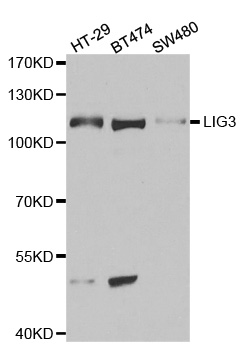DNA ligase III antibody [C2C3], C-term
GTX103197
ApplicationsImmunoFluorescence, Western Blot, ImmunoCytoChemistry
Product group Antibodies
TargetLIG3
Overview
- SupplierGeneTex
- Product NameDNA ligase III antibody [C2C3], C-term
- Delivery Days Customer9
- Application Supplier NoteWB: 1:500-1:3000. ICC/IF: 1:100-1:1000. *Optimal dilutions/concentrations should be determined by the researcher.Not tested in other applications.
- ApplicationsImmunoFluorescence, Western Blot, ImmunoCytoChemistry
- CertificationResearch Use Only
- ClonalityPolyclonal
- Concentration0.15 mg/ml
- ConjugateUnconjugated
- Gene ID3980
- Target nameLIG3
- Target descriptionDNA ligase 3
- Target synonymsLIG2, LIG3alpha, MTDPS20, DNA ligase 3, ligase II, DNA, ATP-dependent, ligase III, DNA, ATP-dependent, polydeoxyribonucleotide synthase [ATP] 3
- HostRabbit
- IsotypeIgG
- Protein IDP49916
- Protein NameDNA ligase 3
- Scientific DescriptionThis gene is a member of the DNA ligase family. Each member of this family encodes a protein that catalyzes the joining of DNA ends but they each have a distinct role in DNA metabolism. The protein encoded by this gene is involved in excision repair and is located in both the mitochondria and nucleus, with translation initiation from the upstream start codon allowing for transport to the mitochondria and translation initiation from a downstream start codon allowing for transport to the nucleus. Additionally, alternate transcriptional splice variants, encoding different isoforms, have been characterized. [provided by RefSeq]
- Storage Instruction-20°C or -80°C,2°C to 8°C
- UNSPSC12352203
References
- Campalans A, Moritz E, Kortulewski T, et al. Interaction with OGG1 is required for efficient recruitment of XRCC1 to base excision repair and maintenance of genetic stability after exposure to oxidative stress. Mol Cell Biol. 2015,35(9):1648-58. doi: 10.1128/MCB.00134-15Read this paper
- Abdou I, Poirier GG, Hendzel MJ, et al. DNA ligase III acts as a DNA strand break sensor in the cellular orchestration of DNA strand break repair. Nucleic Acids Res. 2015,43(2):875-92. doi: 10.1093/nar/gku1307Read this paper
- Kim S, Jo S, Lee H, et al. Lobarstin enhances chemosensitivity in human glioblastoma T98G cells. Anticancer Res. 2013,33(12):5445-51.Read this paper
- Truong LN, Li Y, Shi LZ, et al. Microhomology-mediated End Joining and Homologous Recombination share the initial end resection step to repair DNA double-strand breaks in mammalian cells. Proc Natl Acad Sci U S A. 2013,110(19):7720-5. doi: 10.1073/pnas.1213431110Read this paper




